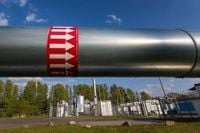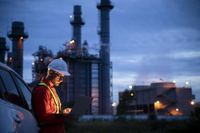In recent days, natural gas prices in Europe and North America have seen significant declines, largely influenced by seasonal demand shifts and broader market dynamics. As of the first ten days of April 2025, spot quotations for natural gas on the Dutch TTF exchange dropped by $102, settling at $390 per 1,000 cubic meters. This downward trend reflects a notable reduction in demand following the end of the heating season, which typically sees a spike in gas usage.
In North America, the American gas exchange Henry Hub reported a decrease in offers, with prices falling to $136 per 1,000 cubic meters on April 4, down from $147 per 1,000 cubic meters just a few days earlier. Interestingly, despite these drops in Europe and North America, Asian spot prices for liquefied natural gas, as measured by the JKM index, remained stable at $430 per 1,000 cubic meters during the same period.
The decline in gas prices is not solely attributed to seasonal factors; it also correlates with falling oil prices. Brent crude oil, for instance, saw a significant drop on the London ICE exchange, plummeting from $74.6 per barrel to $60.5 per barrel between March 31 and April 9. This correlation is critical as gas prices often follow oil prices due to their interconnected markets.
As traders transition into the stockpiling phase, it appears that gas prices may stabilize, preventing further declines. According to the latest data from the AGSI, on April 4, the EU's underground gas storage facilities were 34.6% full, reflecting a 1% increase from the previous week. In the United States, storage facilities reported an increase of 820 million cubic meters, bringing total stocks to 50.2 billion cubic meters, although this figure is still 21.7% lower than the same time last year.
In mid-March, the U.S. Department of Energy adjusted its forecast for the average gas price at Henry Hub for 2025, raising it from $136 per 1,000 cubic meters to $150 per 1,000 cubic meters, indicating expectations of a more stable pricing environment moving forward.
Another significant aspect of the current market is the impact of falling natural gas prices on greenhouse gas emission allowances, which are closely linked. As natural gas prices decrease, the cost of emissions allowances should also drop. This trend is particularly beneficial for industrial enterprises, especially in the metallurgical sector, which rely heavily on gas.
Recent reports indicate that European Emission Allowances (EUAs) fell to €68.7 per tonne by April 3, down from €70.83 per tonne on March 14. Over March, the decline in allowances amounted to €1.87 per tonne, and for the quarter, the total drop reached €4 per tonne.
Despite the positive outlook on gas prices, challenges remain. Danske Commodities, a key player in the energy market, reported a 48% decline in earnings for 2024, citing strong gas market uncertainty and low capture rates for solar energy as significant hurdles for 2025. This indicates that while prices may stabilize, the overall market environment is still fraught with challenges.
In a related development, Germany faces a critical challenge as it seeks to rebuild its depleted gas inventories ahead of the summer refilling season. The country, which holds Europe’s largest gas storage sites, ended the heating season with its lowest stockpiles since 2022. The economic feasibility of refilling these stocks has come into question, as traders require winter gas to be priced significantly higher than summer contracts to ensure profitability after accounting for storage costs.
In contrast, Italy is taking a different approach by implementing subsidies to encourage stockpiling. This strategy aims to bolster its gas reserves and ensure a more stable supply moving into the warmer months.
As Europe navigates these complexities, the regulatory landscape is also evolving. The hydrogen and decarbonized gas market package, which came into effect in August 2024, aims to provide a clear framework for the transport of energy transition gases. This package is expected to enhance the EU's energy resilience and security while promoting strategic autonomy.
Looking ahead, the European Commission is set to release an energy grids package in the fourth quarter of 2025, which will focus on repurposing existing gas grids to bolster competitiveness. At a recent event hosted by ENTSOG and Euractiv, experts discussed the importance of scaling up investments in infrastructure for transporting hydrogen and carbon dioxide, which are seen as crucial for achieving the EU's climate targets.
Andreas Loeffler, Director of the Energy Infrastructure Team of KfW IPEX-Bank, emphasized the need for simplicity in these transitions, advocating for affordable and competitive solutions. He noted, “We’re in competition, not only among member states, but we are mostly also in competition with regions outside of the EU in an increasingly unfriendly geopolitical setup.”
Moreover, discussions at the event revealed differing opinions on the integration of hydrogen technologies across member states. Tsvetelina Penkova, MEP and Vice-President of the ITRE Committee, urged caution against a one-size-fits-all approach, suggesting that member states have unique needs that should guide their energy strategies.
The debate also touched on the merits of blue versus green hydrogen, with experts acknowledging that while green hydrogen produced from renewable sources is the most sustainable option, blue hydrogen, which involves carbon capture, also plays a vital role in the transition.
Ultimately, the discussions underscored the importance of cooperation among energy vectors to ensure a secure and affordable energy future for Europe. As the continent grapples with fluctuating gas prices and evolving regulatory frameworks, the path forward will require careful navigation of both market dynamics and technological advancements.








